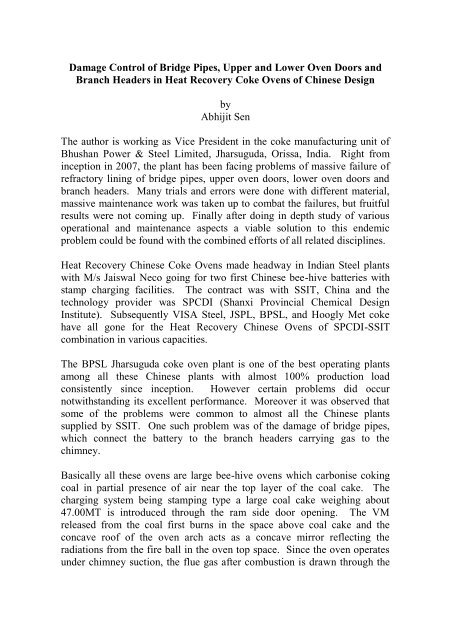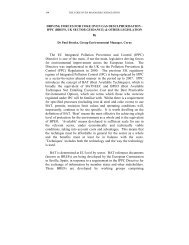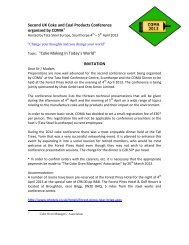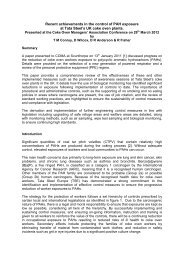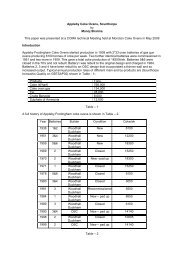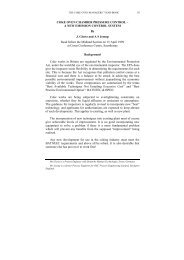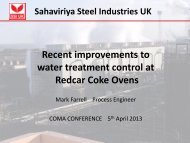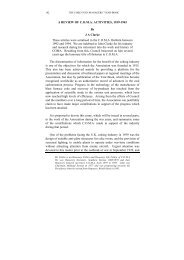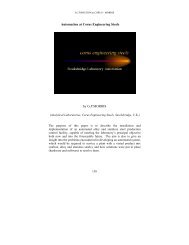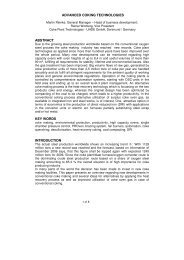THE YEAR-BOOK OF THE COKE OVEN - Coke Oven Managers ...
THE YEAR-BOOK OF THE COKE OVEN - Coke Oven Managers ...
THE YEAR-BOOK OF THE COKE OVEN - Coke Oven Managers ...
Create successful ePaper yourself
Turn your PDF publications into a flip-book with our unique Google optimized e-Paper software.
Damage Control of Bridge Pipes, Upper and Lower <strong>Oven</strong> Doors andBranch Headers in Heat Recovery <strong>Coke</strong> <strong>Oven</strong>s of Chinese DesignbyAbhijit SenThe author is working as Vice President in the coke manufacturing unit ofBhushan Power & Steel Limited, Jharsuguda, Orissa, India. Right frominception in 2007, the plant has been facing problems of massive failure ofrefractory lining of bridge pipes, upper oven doors, lower oven doors andbranch headers. Many trials and errors were done with different material,massive maintenance work was taken up to combat the failures, but fruitfulresults were not coming up. Finally after doing in depth study of variousoperational and maintenance aspects a viable solution to this endemicproblem could be found with the combined efforts of all related disciplines.Heat Recovery Chinese <strong>Coke</strong> <strong>Oven</strong>s made headway in Indian Steel plantswith M/s Jaiswal Neco going for two first Chinese bee-hive batteries withstamp charging facilities. The contract was with SSIT, China and thetechnology provider was SPCDI (Shanxi Provincial Chemical DesignInstitute). Subsequently VISA Steel, JSPL, BPSL, and Hoogly Met cokehave all gone for the Heat Recovery Chinese <strong>Oven</strong>s of SPCDI-SSITcombination in various capacities.The BPSL Jharsuguda coke oven plant is one of the best operating plantsamong all these Chinese plants with almost 100% production loadconsistently since inception. However certain problems did occurnotwithstanding its excellent performance. Moreover it was observed thatsome of the problems were common to almost all the Chinese plantssupplied by SSIT. One such problem was of the damage of bridge pipes,which connect the battery to the branch headers carrying gas to thechimney.Basically all these ovens are large bee-hive ovens which carbonise cokingcoal in partial presence of air near the top layer of the coal cake. Thecharging system being stamping type a large coal cake weighing about47.00MT is introduced through the ram side door opening. The VMreleased from the coal first burns in the space above coal cake and theconcave roof of the oven arch acts as a concave mirror reflecting theradiations from the fire ball in the oven top space. Since the oven operatesunder chimney suction, the flue gas after combustion is drawn through the
four linked arches below the sole, the vertical uptakes, the bridge pipes, thebranch headers, and the main headers leading to the chimney. Theoreticallythe temperature of the oven top arch region should be 1200-1250°C and thatat the sole flue should be about 1300-1350°C. The fire in the oven is to beso controlled that the entire combustion of the evolved volatile matter burnsout in the oven and the sole flue. No un-burnt coke oven gas should escapethe sole flue. In the uptake region and in the bridge pipe the temperature ofthe flue gas should be below 1100°C.The RefractoryThe typical refractory constitution of the oven arch, the oven sole, the soleflue and the oven walls are all made of silica bricks which are well suited tobear temperatures up to 1450°C. The bridge pipes are metal fabricationslined with ceramic fibre board and ceramic fibre castable which can standtemperatures up to 1250°C. These bridge pipes connect the battery to thebranch headers, which are lined with folded modules of ceramic fibreblanket. The specified temperature in the branch header is about 1000°Cand the refractory installed is also suitable to withstand this temperature. Inthe Chinese design the door linings were also made of ceramic fibre boardand ceramic fibre castable. The use of ceramic fibre in door, bridge pipeand headers was mainly recommended to reduce the weight of therefractory lining in these areas.Replacement of a branch header segment is in progress in COP
The History of Damages1. Upper <strong>Oven</strong> DoorsThe damages of the upper oven door started with a small defect in theimplementation work of the lining during project stage. It was wrongerection of one row of L-shaped bricks at the bottom of the upper door.Although the entire linings of upper and lower doors were executed underclose supervision of Chinese experts, this small item was over looked. Theproblem was detected when all doors were erected and the plant wascommissioned and was subsequently taken on range for full load operation.Although the first upper door replacement was done in August 2008, thedamage actually had started much earlier along with lower oven doors. Dueto faulty erection, the bricks started coming out one by one and the castable,which took support from these bricks, collapsed gradually, exposing theceramic fibre board layers as well as the lower metallic edge of the cast irondoor to direct heat. The lower edge and some portion of the exposed ribstarted melting down. The molten iron falling on the lower doors starteddamaging the lower doors.Refractory lining work of upper oven door is in progress in COP
2. Lower <strong>Oven</strong> DoorsAs stated above damage and melting down of upper oven doors causedextensive damage of lower oven doors also. The molten iron falling on therefractory lining of lower oven door first damaged the refractory, whichgave way, exposing the lower door metal to direct heat. The ribs of lowerdoor melted down. Thus a large number of lower doors also got heavilydamaged and became unserviceable. The first replacement activity ofLower <strong>Oven</strong> Doors was started in March 2008.Refractory lining work for lower oven doors in progress in COP3 Bridge PipesBridge pipes are breather pipes for ovens and serve as nostrils for the ovenchambers. Each oven therefore has two bridge pipes connected to twoseparate branch headers – one at pusher side and the other at coke side.These create the necessary suction inside the oven uniformly from bothends for inhaling combustion air into the free space above the coal cake.The inhaled air helps burning of volatile substances given out of the coalcake and creating a fireball which radiates heat in all directions. The archedoven roof serves as a concave mirror and reflects the radiations in parallelvertical rays falling on the coal cake.
External view of a damaged bridge pipe at COP in BPSLEntry of air into the oven should be so controlled that 80% of thecombustion is completed in the oven top free space below the arch roof andrest of the unburned gas along with the hot burnt flue gas travels down tothe sole flue which is divided into four linked arches below the oven sole.Secondary combustion air is introduced in the sole flue to complete thebalance 20% combustion and the hot inert flue gas devoid of anycombustible constituent is allowed to go up the uptakes to the bridge pipes,the branch header and finally to the chimney via the waste heat boiler forrecovery of waste heat from the hot flue gases for generation of power.Internal view of a damaged bridge pipe at COP in BPSL
The damage of bridge pipes commenced from the early days ofcommissioning. The commissioning of Battery Nos. 7 and 8 startedtowards end of December 2007. There after sequentially other batterieswere commissioned in January 2008 (No.5 and 6), March 2008 (No. 3 and4) and May 2008 (No.1 and 2). The damage of bridge pipes started in themonths of January-February 2008 and the first replacement was done inoven No. 86 coke side (Battery#8) on 13.02.2008. It means that the damageof bridge pipe had commenced within a month’s time of firstcommissioning. During subsequent months replacement of damaged bridgepipes went on as follows: March 2008-3, April 2008-3, May 2008-6, June2008-7, July 2008-8, August 2008-5, September 2008-5, October 2008-7,November 2008-6, December 2008-10 and so on. Thus year wise bridgepipe replacements were: 2008-61 Nos. 2009-147 Nos. and 2010 (till July) -66 Nos. There was a time when bridge pipes became damaged within a fewdays of installation.Internal lining work of bridge pipe is in progress in coke oven plant
DamageGood ConditionDamageGood ConditionDamageGood ConditionDamageGood ConditionDamageGood ConditionDamageGood ConditionDamageGood ConditionDamagedConditionGood ConditionDamagedConditionGood ConditionObservations and Remedial ActionsUpper <strong>Oven</strong> DoorsThe first action with regard to the upper oven door was to make somechanges in the design of the liner. The L-shaped bricks were replaced withdense castable LC-45, cast on L-shaped ss-anchorage. Ceramic fibrecastable of the main body was replaced with insulating castable Insulite-15.Top surface was finished with 70 mm LC-45 dense castable. About 78upper oven doors have been replaced with the new lining since 31stSeptember 2009. None of these freshly lined doors have failed so far.175150125100755025174 18 153 39 138 54 126 66 120 72 111 81 97 95 96 96 90 102031.09.2009 31.12.2009 28.02.2010 31.03.2010 30.04.2010 31.05.2010 30.06.2010 31.07.2010 31.08.2010Chart showing gradual decline of damaged upper doors vis-à-vis increasingnumbers in good conditionThere is a proposal to use ceramic fibre modules for upper door lining.Orders have already been placed for imported and indigenous modulesparticularly for the upper door lining, the results of which can be seen onlyafter installation.
DamageGood ConditionDamageGood ConditionDamageGood ConditionDamageGood ConditionDamageGood ConditionDamageGood ConditionDamageGood ConditionDamagedConditionGood ConditionDamagedConditionGood ConditionLower <strong>Oven</strong> DoorsThe first instance of damage of lower oven door commenced almost within2-3 months of first start up of coke oven Battery # 7 and 8. Similar to theupper door lining, changes were made in the lower door lining also. Mainlythe peripherals, which receive maximum external abrasions, were lined withdense LC-45 castable on top of Hysil boards. We are giving pictorialrepresentation of the extent of repair done almost over a year after 31stSeptember 2009. None of these freshly lined doors have failed to date.Bridge PipesIt was observed that the ceramic fibre lining of the bridge pipes were failingrepeatedly and fallen refractory material were blocking the suction ports. Itwas also observed initially that the temperature inside the bridge pipes wasshooting up as high as 1450°C leading to fusion and melting down of notonly the refractory material but also the mild steel body of the bridge pipes,creating gaping holes.200175150125100755025107 85 57 135 17 175 10 182 6 186 5 191 13 179 7 185 4 188031.09.2009 31.12.2009 28.02.2010 31.03.2010 30.04.2010 31.05.2010 30.06.2010 31.07.2010 31.08.2010Chart showing gradual decline of damaged bridge pipes vis-à-vis increasingnumbers in good condition.
DamageGoodConditionDamageGoodConditionDamageGoodConditionDamageGoodConditionDamageGoodConditionDamageGoodConditionDamageGoodConditionDamagedConditionGoodConditionDamagedConditionGoodConditionIt was also observed that certain amounts of combustibles were beingcarried over to the bridge pipe region. The operating procedure beingfollowed at that point of time (before 31.09.2009) had a flaw, though it wasas per instruction of the Chinese suppliers. The 2 numbers primary airwindows provided in the upper oven doors were completely closed for theinitial 3 hours after charging of ovens. Since the plant was being operatedalmost at full load, one oven was being pushed and charged every 45minutes. As a result un-burnt volatiles escaped continuously to the bridgepipe and branch headers. Another mistake, which further aggravated theproblem was that a tertiary hole was made by some agency at the bottom ofuptake just after the 4-linked arch which provided additional combustion airto the un-burnt volatiles.150125100755025148441009279113701226312953139501425114147 145031.09.2009 31.12.2009 28.02.2010 31.03.2010 30.04.2010 31.05.2010 30.06.2010 31.07.2010 31.08.2010Chart showing gradual decline of damaged lower doors vis-à-vis increasingnumbers in good condition.A third observation was that when bridge pipes were being changed, fluehole cleaning was overlooked at times and also bridge pipes were beingchanged only on one side (either coke side or pusher side) ignoring the
condition of the other side. This resulted in more flow of gas through oneof the bridge pipes leading to higher temperature and meltdown.The following steps were taken to overcome the problem of bridge pipefailure:a) Immediate plugging of tertiary holes with a strict instruction --never to open them in futureb) Keeping the primary air windows open right from the time aftercharging, closing it fully only when the oven is ready andregulating it in between as per combustion requirementc) Keeping the levels of the combustibles in flue gas, particularlycarbon monoxide and hydrogen at trace levelsd) To take up bridge pipe replacement either simultaneously on bothcoke side and pusher side or at small gap of maximum 1 weeke) Use of dense castable LC-45 in the top layer in contact with the hotgasf) To do compulsory suction port cleaning with every bridge pipereplacementAbove steps have brought in drastic improvements in the condition and lifeof the bridge pipes and their lining. Over the last year more than 100 out ofa total of 192 bridge pipes have been replaced, which have not failed as yet.With full load operation at 36 pushing/day, some damages temporarilyresurfaced but was again under control. The key to the solution of theproblem was basically lowering the temperature of the flue gas to about1100-1150°C, which is as per design and the liner material can withstandthe same.The Author is grateful to the entire <strong>Coke</strong><strong>Oven</strong> team of BPSL, Orissa for theirrelentless efforts in bringing about theimprovements in the Operation andMaintenance of the subject <strong>Coke</strong> <strong>Oven</strong>plant.


